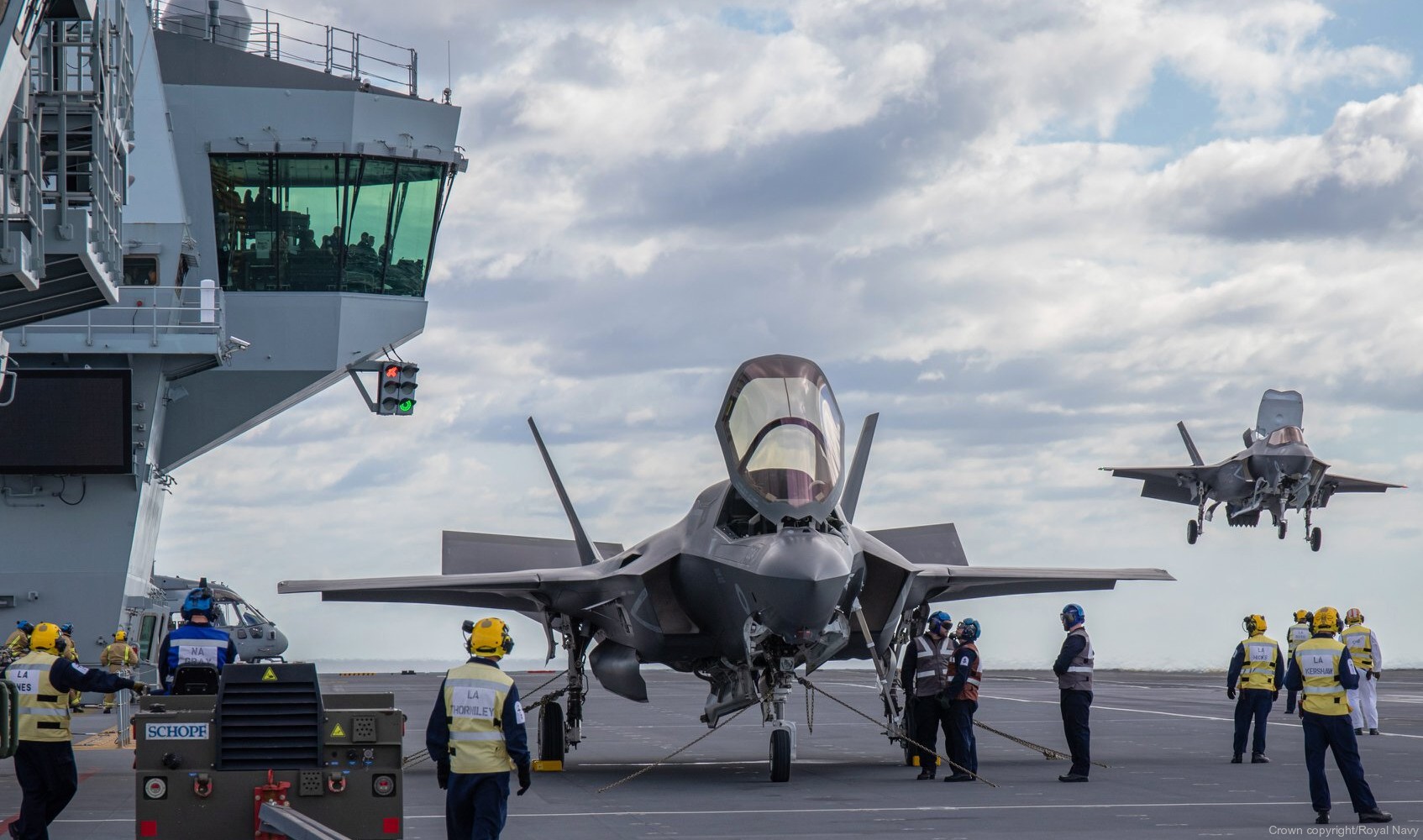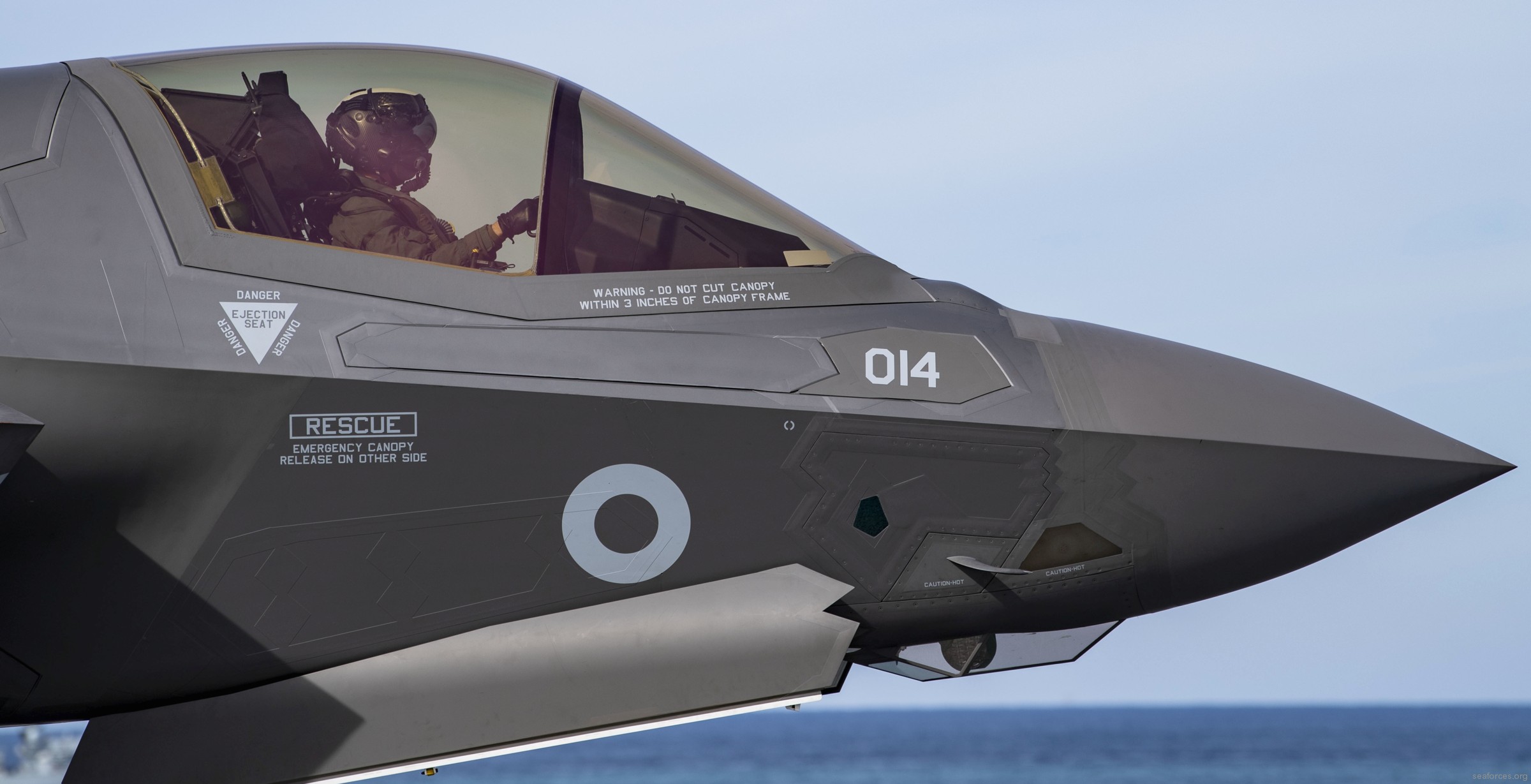 |
||||
|
HOME
|
US Navy -
ships
|
US Navy - air
units
|
USMC - air
units
|
International
Navies
|
Weapon Systems
|
Special Reports |
||||
|
|
||||
|
|
||||
|
Royal Navy / Fleet Air Arm F-35B Lightning II |
||||
|
|
||||
 |
||||
|
|
||||
| Units: | ||||
NOTE: The F-35B Lightning II aircraft will be jointly operated by pilots from the Fleet Air Arm and the Royal Air Force |
||||
|
The United Kingdom's Royal Air Force and
Royal Navy both operate the F-35B, known simply as the Lightning in
British service; it has replaced the Harrier GR9, which was retired
in 2010, and Tornado GR4, which was retired in 2019. The F-35 is to
be Britain's primary strike aircraft for the next three decades. One
of the Royal Navy's requirements for the F-35B was a Shipborne
Rolling and Vertical Landing (SRVL) mode to increase maximum landing
weight by using wing lift during landing. In July 2013, Chief of the
Air Staff, Air Chief Marshal Sir Stephen Dalton announced that No.
617 (The Dambusters) Squadron would be the RAF's first operational
F-35 squadron. The second operational squadron will be the Fleet Air
Arm's 809 Naval Air Squadron in April 2023. No. 17 (Reserve) Test and Evaluation Squadron (TES) stood-up on 12 April 2013 as the Operational Evaluation Unit for the Lightning, becoming the first British squadron to operate the type. By June 2013, the RAF had received three F-35s of the 48 on order, all initially based at Eglin Air Force Base. In June 2015, the F-35B undertook its first launches from a ski-jump at NAS Patuxent River. When operated at sea, British F-35B shall use ships fitted with ski-jumps, as will the Italian Navy. British F-35Bs are not intended to receive the Brimstone 2 missile. On 5 July 2017, it was announced the second UK-based RAF squadron would be No. 207 Squadron, which reformed on 1 August 2019 as the Lightning Operational Conversion Unit. No. 617 Squadron reformed on 18 April 2018 during a ceremony in Washington, D.C., US, becoming the first RAF front-line squadron to operate the type; receiving its first four F-35Bs on 6 June, flying from MCAS Beaufort to RAF Marham. Both No. 617 Squadron and its F-35s were declared combat ready on 10 January 2019. In April 2019, No. 617 Squadron deployed to RAF Akrotiri, Cyprus, the type's first overseas deployment. On 25 June 2019, the first combat use of an RAF F-35B was reportedly undertaken as armed reconnaissance flights searching for Islamic State targets in Iraq and Syria. In October 2019, the Dambusters and No. 17 TES F-35s were embarked on HMS Queen Elizabeth for the first time. No. 617 Squadron departed RAF Marham on 22 January 2020 for their first Exercise Red Flag with the Lightning. The F-35B is the short takeoff and vertical landing (STOVL) variant of the aircraft. Similar in size to the A variant, the B sacrifices about a third of the A variant's fuel volume to accommodate the Rolls-Royce LiftSystem. This variant is limited to 7 g. Unlike other variants, the F-35B has no landing hook. The "STOVL/HOOK" control instead engages conversion between normal and vertical flight. General characteristics: Crew: 1 Length: 51.2 ft (15.6 m) Wingspan: 35 ft (10.7 m) Height: 14.3 ft (4.36 m) Wing area: 460 sq ft (42.74 m2) Empty weight: 32,472 lb (14,729 kg) Max takeoff weight: 60,000 lb (27,200 kg) Weapon payload: 15,000 lb (6,800 kg) Fuel capacity: 13,500 lb (6,123 kg) internal Range: 900 nmi (1,700 km) Combat radius: 505 nmi (935 km) on internal fuel Service ceiling: 50,000 ft (15,000 m) g limits: +7.0 Powerplant: 1 x Pratt & Whitney F135-PW-600 two-spool, axial flow, augmented turbofan with shaft driven remote lift fan Maximum thrust: 27,000 lbf (120 kN) military thrust / 41,000 lbf (182 kN) with afterburner / 40,650 lbf (181 kN) hovering Maximum speed: Mach 1.6 at altitude Armament: Gun: 1 x 25 mm (0.984 in) GAU-22/A 4-barrel rotary cannon, 180 rounds Hardpoints: 4 x internal stations, 6 x external stations on wings with a capacity of 5,700 pounds (2,600 kg) internal, 15,000 pounds (6,800 kg) external, 18,000 pounds (8,200 kg) total weapons payload,with provisions to carry combinations of: Missiles: Air-to-air missiles: AIM-120 AMRAAM AIM-9X Sidewinder AIM-132 ASRAAM MBDA Meteor (Block 4) Air-to-surface missiles: AGM-88G Extended Range Advanced Antiradiation Guided Missile (AARGM-ER) AGM-158 Joint Air-to-Surface Standoff Missile (JASSM) Select Precision Effects At Range (SPEAR) Capability 3 (SPEAR 3) AGM-179 Joint Air-to-Ground Missile (JAGM) Joint Strike Missile (JSM, planned) Anti-ship missiles: AGM-158C Long Range Anti-Ship Missile (LRASM) Bombs: Joint Direct Attack Munition (JDAM) series Paveway series laser-guided bombs Small Diameter Bomb (SDB) AGM-154 JSOW Mk.20 Rockeye II cluster bomb Mk 77 incendiary bombs Wind Corrected Munitions Dispenser (WCMD) capable B61 Mod.12 nuclear bomb Avionics: AN/APG-81 AESA radar AAQ-40 E/O Targeting System (EOTS) AN/AAQ-37 Distributed Aperture System (DAS) missile warning system AN/ASQ-239 Barracuda electronic warfare system AN/ASQ-242 CNI suite, which includes: Harris Corporation Multifunction Advanced Data Link (MADL) communication system Single Channel Ground and Airborne Radio System (SINCGARS) An IFF interrogator and transponder HAVE QUICK - ECM resistant frequency-hopping system AM, VHF, UHF AM, and UHF FM Radio GUARD survival radio Tactical air navigation system (TACAN) Instrument carrier landing system Joint precision approach and landing system (JPALS) TADIL-J JVMF/VMF / Link 16 source: wikipedia |
||||
| images | ||||
                               |
||||
|
|
||||
|
|
seaforces.org
|
Royal
Navy start page
| |

